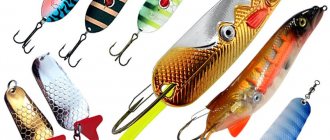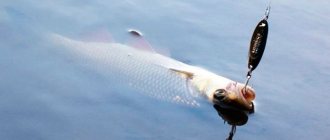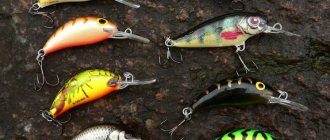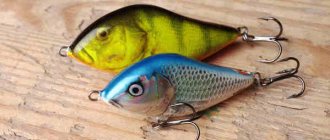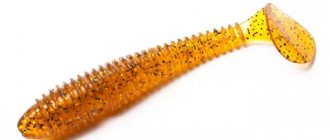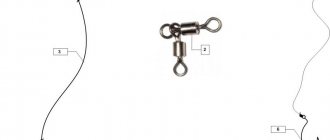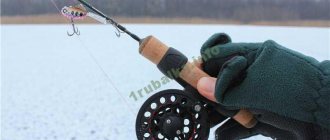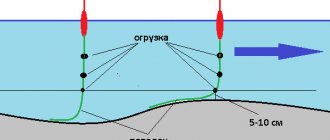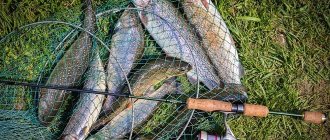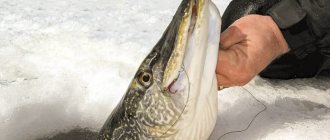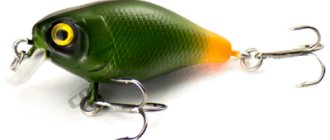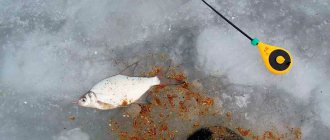TOP popular products for fishing
— buy with good discounts for personal use and as a gift to friends and acquaintances.
Buy quality products at affordable prices in the best fishing online stores
. Give gifts to yourself and your loved ones!
we are in social networks
— subscribe to us on Facebook, Youtube, VKontakte and Instagram. Stay up to date with the latest site news.
Every spinner tries to force a predator to attack the bait. To do this, you need to master the wiring technique. Beginning fishermen try to cast the bait as far as possible, and after it falls, they immediately begin reeling. At the same time, they do not always know exactly at what horizon the spinner should be cast and at what speed to rotate the reel handle. In such cases, it is difficult to count on effective fishing. Most likely, a random pike or perch is caught on the tee.
If you take a closer look at the more experienced spinning anglers who fish nearby, they are able to catch perch and pike. But this is a standard situation. Every experienced angler once started and made various mistakes. The fact is that spinning fishing is such that a person only with practice acquires the necessary skills and learns the correct methods of fishing. Only sensory sensations and accumulated experience allow you to determine at what depth to lead the lure, when to pause, jerk or increase the pace of reeling.
After many fishing trips, you can learn how to play the spoon correctly and serve it at different horizons. You need to have a certain skill to make the spoon move from side to side. It is not always easy to throw a lure in such a way that there is no unnecessary noise. It is difficult to fish in snags without getting caught in them.
Casting spinners
Let's look at two turntables. One of them has a weight of 15 grams and a petal weighing 8 grams, and the second has a weight of 17 grams and a petal weighing 6 grams. The configuration of the baits is approximately the same.
In the first case, during the flight the weight will be behind the petal. When casting the second spoon, the weight will outpace the blade and reach the water faster. In two cases, the landing of the baits will be noisy and splashing. Naturally, after such casts it is difficult to count on fish bites. It is always necessary to achieve the most quiet landing of the spinner with a load. The ideal option is when first the petal reaches the surface of the water, and then the weight. In this case, the fish will immediately see the spoon and, perhaps, become interested in it. If she sees an object noisily falling on the water, she will most likely ignore it.
How to make the spoon lie quietly on the water? At the final stage of the bait’s flight, half a meter before the surface of the water, you should slow down the cord or fishing line coming off the spool. To do this, you need to lightly press your finger against the spool and lift the rod up a little. In this way, it turns out that the line, forming an arc in the air, will straighten out and the bait will fly parallel to the water and fall almost silently. If you continue to hold the rod in an elevated state, the spoon will actively play in the water, reminiscent of a fry fleeing. In such cases, perches and sometimes pike often bite.
But sometimes during such casts the tee gets tangled with the main line or leader.
You need to accept this as inevitable and not get upset again. If the wind blows in the direction of casting, then you can achieve a good flight range of the bait. You just have to throw the spoon higher, and the wind will push it. True, in this case it will fall more noisily. To reduce noise, you should slow down the rotation of the spool a little earlier, approximately 2 meters before the spoon touches the surface of the water. All actions are performed quickly and automatically.
At first it will be difficult for a beginner to control the bait in windy conditions. First of all, you should learn to hold the spool and slow down the fall of the bait. Then move on to the next stage of maneuvering the rod.
Posting
When the spinner with the load ends up in the water, the speed of their fall will noticeably decrease, since the resistance in the water is much higher. In this case, the fishing line will immediately weaken and lie on the surface of the water. If we slowed down the line on the spool, the load would sink. Moreover, it will not fall vertically, but in an arc similar to the trajectory that is obtained during the flight of the fishing line. The greater the depth at the place where the spoon falls, the more similar the trajectory of the spoon falling onto the arc will be.
When the line lays on the water, it initially weakens, and then stretches out again. The spinner's task is to determine the moment when the bait touches the bottom and how long it will take to fall. It's pretty easy to install. You just need to time the fall. If you use a spoon weighing 7 grams with a weight of 17 grams, then it will cover 10 meters in about 19-20 seconds.
Measuring the bottom and counting the time the bait falls is very important. This way you will always know how far your lure is from the bottom. This is especially important to do in situations where you are fishing in snags. Having determined at what depth the snags are located, next time you will know at what count you should start reeling in order to avoid snags.
If earlier this method of studying the depth by identifying snags was almost the only one for those who fished from the shore, now another one has appeared. You can use a wireless echo sounder. It is enough to attach the sensor to the main fishing line, and on the device screen you will see the depth and topography of the bottom.
Experienced spinners have already developed the habit that they always count from the moment the spoon touches the surface of the water. On little-studied reservoirs it is better to use a weight. With its help, you can more or less accurately determine the depth and avoid unnecessary losses of bait. It should be remembered that a load weighing 35 grams falls at a speed of 1 m/s.
If you don’t wait for the bait to land and start reeling, it will first go up, and when the reeling rate decreases, it will move parallel to the bottom. If you start reeling when the load with the spoon reaches the bottom, then at first the bait will go parallel to the bottom. It is necessary to make several jerks to tear the spoon off the bottom and immediately begin reeling. Then we look, if the spoon strikes the bottom, then we slightly increase the speed of rotation of the reel and slightly raise the rod. If the spoon does not touch the bottom, then we do not change the rotation speed. These moments need to be felt. Depending on whether we need the bait to touch the bottom or not, we choose one or another lure tactic.
It matters whether there is grass or debris at the bottom or not. If something else clings to the hooks, then there will be no bites. As a result, the game is lost, and the predator perceives the moving object as something of little interest and ignores it.
When the lure is thrown to the bottom, you can hope that the pike will show interest in it. Often she grabs it at the moment of separation from the bottom. If there is no bite, then you can reel out the tackle in order to quickly cast into the area of interest to us. You should be alert while exhausting. In the summer, pike sometimes catches up with the spoon and can take it right near the shore or boat. At such moments, it is important not to get confused and to hold the rod well in your hand without stopping rotating the reel handle.
How to properly lead a spinner on different horizons? Having counted out the allotted amount of time, we begin to perform the retrieve at such a speed that the spinner passes at a certain depth and demonstrates its characteristic game. To understand which game is suitable for a particular spoon, it is better to practice in a shallow area with clean water. This way you can see with your own eyes how the bait behaves at different fishing speeds and during pauses of different lengths.
The simplest wiring is uniform. It is clear that even movement of the bait at the same speed is not always enough. Often you need to change the speed of the spinner, make stops, jerks and change the fishing horizon. Experienced spinners know well how to lead this or that spinner and what techniques the pike responds to best during the game.
The main condition for successful catching of a predator is the natural action of the spinner. It is optimal to drive it at medium speed. When fishing for pike in the bottom area, slow down the bait by rotating the reel handle more slowly. In areas with great depth, it is better to use spoons with heavy weights, which reach the bottom faster.
Wiring a Wobbler for Pike
Wobblers: classification and types of wiring. The best wobbler. Wobbler rating. Minnow wobblers.
pike #fishing #cgf53 Fishing reports, photos in the official channel group: vk.com/cgf53 My thoughts about wobblers.
The pike goes crazy with this wobbler! The best wobbler fishing for pike!
We hope you liked this video, you can send your questions and suggestions by email: ✅https://v.
Twitching pike / Working wobblers
Pike fishing by twitching on the Psel River in the fall of 2021. Pike fishing, working wobblers. Usami Ebisu, Jackall Magsquad 115 Mine.
Twitching technique: popular beginner mistakes
Continuation of the popular video: Twitching for beginners. How to fish with wobblers
This is the release.
Correct Twitching for beginners and pros. Postings and techniques for their implementation.
Boats and motors: https://kapitan.ua/ Favorite New Spirit New: https://goo.gl/8QLo1R Fishing has always been my favorite hobby. I have.
I picked up the wiring and it started! Fishing on the Oka! Pike on a wobbler!
I fished in the backwater with wobblers. On this day, the pike preferred a slow retrieve.
Twitching for beginners. How to fish with wobblers.
This video talks about the twitching technique, wiring and other intricacies of this type of spinning fishing.
Focus on the wobbler. Catching pike on twitch. Twitching wiring + Competition
While there is a spawning ban on the rivers, I decided to get out to the lake near Kyiv. And for how much?
FISHING for PIKE wobblers under water
wobbler store https://bearking.com.ua/
Surface baits (wobblers from my box).
Surface baits or topwaters - wiring and specifics of using surface baits. Popper.
Fishing for inactive pike, choosing the color of the wobbler and wiring
Another short fishing trip on a local reservoir brought surprises, at first I couldn’t find anything.
Pinwheels and wobblers under water
It was evening, there was nothing. The fish didn’t bite at all)))) I found a wobbler on Aliexpress for 49 rubles.
Tricky wiring for PIKE! Pike fishing LINES AND LURES! Fishing from the shore with silicone Fanatic
Tricky wiring for PIKE! Pike fishing LINES AND LURES! The most catchy bait on this fishing trip https://fanatik.com.
Wiring minnow wobblers
Wiring minnow wobblers - practice, developments, observations.
Wobblers for catching pike in early spring! Fishing for pike during spawning
I have been using this set of wobblers consistently for the 4th year, if not more. These are proven and working models.
Twitching wobblers: Correct pause! Fishing will be more fun, the pike will bite bigger!))
Favorite New Spirit New 602H, 1.83m 12-35g Fast: https://goo.gl/bBe8EA Excellent winter suit float -5%: https://ohota-rybalka.in.ua Boats and motors.
Kalikana 70SP-SR Pontoon21 Effective fishing for pike.
This was my first acquaintance. Effective wiring was quickly selected. The strength of the jerks is getting better.
Top wobblers for pike. 2021. Catching wobblers. Pike fishing 2021.
My top wobblers for pike that were great for catching in 2019-2020. Wobblers that always catch. Catchable wire.
These wobblers MOW down pike CATCHING PIKE with a wobbler
The entire range of products is at a 20% discount using the promotional code “FISHING DAYS” in the Big River store https://bit.ly/2HceGI8 Bag https://bi.
Basic techniques for guiding ShED wobblers for pike and perch
The catchability of wobblers depends on many reasons, one of the most important of which is animation (wiring).
Catching PIKE in the reeds. Secret wobbler and wiring tricks
How to catch a pike in the reeds. Review of the Yo-Zuri L-Minnow wobbler. Wobbler game. Wiring tricks. Fishing tactics. Review.
130th wobblers: features of autumn fishing for pike
In this form we will talk about large wobblers in size 130 mm and the passive wiring technique in the autumn.
Fishing for pike in grass thickets Wobblers and spinners
Our Website – https://onlyspin.ru/ VK Page: https://vk.com/onlyspin Facebook: https://www.facebook.com/onlyspin Hashtag on Instagram #OnlySpin I want it right away.
Posting an oscillating spoon
Wiring oscillators of different shapes. How to properly cast a lure when fishing for pike and perch. How to catch a spinner.
Pike fishing in winter, wiring wobblers
Winter spinning 2021. Wobbler wiring technique. Twitching Spinning for twitching rudra and other large wobblers.
Classification and wiring of wobblers
Today in the “Fishing Secrets” program we will look at the most popular wobblers for catching predators.
Jackall Mag Squad 128 SP - the best wobblers for pike
MagSquad 128 is one of the most stable wobblers of 2015, I strictly recommend it to lovers of all plastic fish
